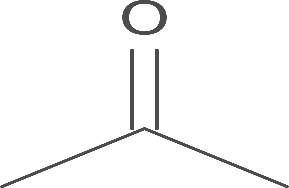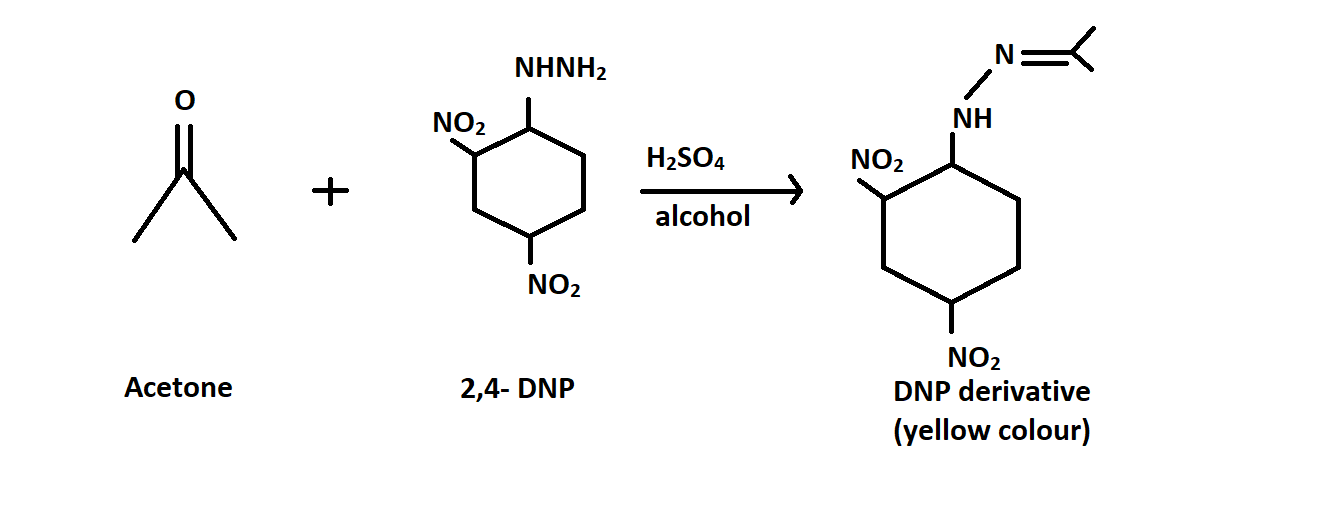
Acetone gives positive test with:
A. Fehling's solution
B. Schiff's solution
C.
D. all of the above
Answer
482.4k+ views
Hint:Before solving the question, the first thing to keep in mind is that acetones belong to the ketone functional group. Ketones do not have the hydrogen (attached to carbon – oxygen double bond) which is present in aldehydes.
Complete step by step answer:
-Fehling’s solution is a reagent which is used to differentiate between reducing and non-reducing sugars, to determine whether a carbonyl compound is an aldehyde or ketone.
-Schiff’s solution is a reagent which is used to detect presence of aldehydes.
-
We know that acetone belong to the ketone functional group category having the following structure:

-Acetones in general do not respond to Fehling’s test , because they do not have the hydrogen (attached to carbon – oxygen double bond which is present in aldehydes) which will undergo oxidation, hence it is difficult to oxidise them with this solution. Ketones are very less reactive towards oxidation.
-Similarly Schiff’s reagents do not bring about oxidation in ketones. Thus option A and B are incorrect.
-Acetone, however reacts with

Therefore Option C is correct.
Additional Information:
Fehling’s solution is actually a deep blue alkaline solution prepared by combining two different solutions. First is Fehling’s A which is copper (II) sulphate solution, deep blue in colour and the other is Fehling’s B which is a solution of aqueous sodium potassium tartrate (also known by the name Rochelle salt) which is colourless. These two are mixed and made strongly alkaline by adding potassium hydroxide (
Schiff’s solution is Fuchsine or rosaniline which is a magenta coloured dye having the chemical formula
Note:
We need to be careful with Fehling’s test as some
Complete step by step answer:
-Fehling’s solution is a reagent which is used to differentiate between reducing and non-reducing sugars, to determine whether a carbonyl compound is an aldehyde or ketone.
-Schiff’s solution is a reagent which is used to detect presence of aldehydes.
-
We know that acetone belong to the ketone functional group category having the following structure:

-Acetones in general do not respond to Fehling’s test , because they do not have the hydrogen (attached to carbon – oxygen double bond which is present in aldehydes) which will undergo oxidation, hence it is difficult to oxidise them with this solution. Ketones are very less reactive towards oxidation.
-Similarly Schiff’s reagents do not bring about oxidation in ketones. Thus option A and B are incorrect.
-Acetone, however reacts with

Therefore Option C is correct.
Additional Information:
Fehling’s solution is actually a deep blue alkaline solution prepared by combining two different solutions. First is Fehling’s A which is copper (II) sulphate solution, deep blue in colour and the other is Fehling’s B which is a solution of aqueous sodium potassium tartrate (also known by the name Rochelle salt) which is colourless. These two are mixed and made strongly alkaline by adding potassium hydroxide (
Schiff’s solution is Fuchsine or rosaniline which is a magenta coloured dye having the chemical formula
Note:
We need to be careful with Fehling’s test as some
Recently Updated Pages
Master Class 9 General Knowledge: Engaging Questions & Answers for Success

Master Class 9 English: Engaging Questions & Answers for Success

Master Class 9 Science: Engaging Questions & Answers for Success

Master Class 9 Social Science: Engaging Questions & Answers for Success

Master Class 9 Maths: Engaging Questions & Answers for Success

Class 9 Question and Answer - Your Ultimate Solutions Guide

Trending doubts
Draw ray diagrams each showing i myopic eye and ii class 12 physics CBSE

Why do the transition elements have higher enthalpies class 12 chemistry CBSE

What are the advantages of parallel combination over class 12 physics CBSE

What are the causes of overloading class 12 physics CBSE

How do you convert from joules to electron volts class 12 physics CBSE

There is hypertension due to smoking Give scientific class 12 biology CBSE




